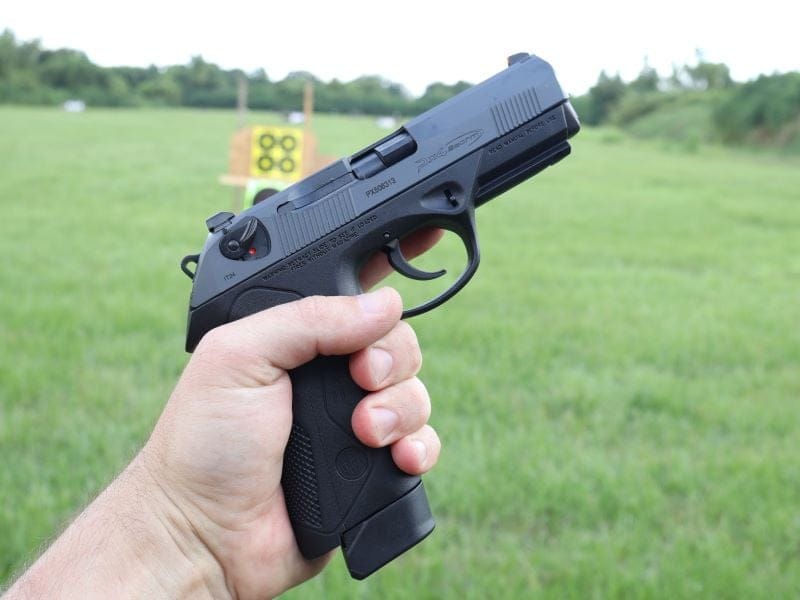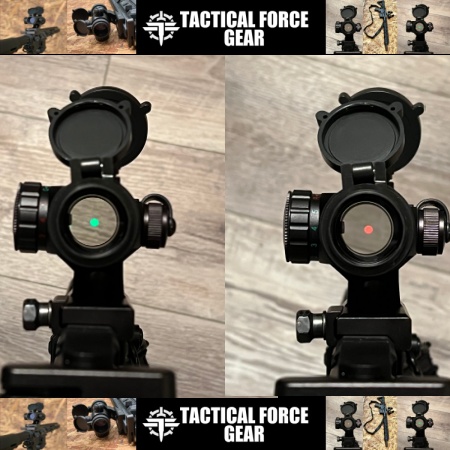The Beretta Px4 Storm is something of a sleeper gun. It is neither obscure nor ubiquitous, but it is a well-appointed and high-quality pistol designed to bridge the gap between lighter polymer-framed pistols and the traditional and trusted double-action hammer-fired handguns that had made Beretta into a worldwide entity.
Since coming onto the scene in 2004, the Px4 Storm has seen its fair share of adoptions and models dedicated to duty and concealed carry, ranging in calibers from 9mm to .40 S&W and .45 ACP. I have always advocated for the virtue of double-action pistols, even over more ubiquitous striker-fired guns. But I am also a fan of the classics, and the Beretta Px4 Storm often escaped my mind.
However, upon reading the news that the Langdon Tactical Beretta Px4 G-SD won Best Competition Gun for 2024 at the Industry Choice Awards, I decided that the time was right to delve into what the Px4 Storm has to offer. I came into the new G-SD model to accomplish that mission and see how a 20-year-old model was receiving renewed praise.
Px4 Storm G-SD: Quirks and Features
Although it is not as well-known as pistols like the Beretta 92 or Cheetah, the Px4 Storm has been out and about since 2004. The development of the G-SD model, in particular, is a collaboration between Langdon Tactical Technology and Beretta toward that twentieth anniversary. Langdon has done excellent work at taking Beretta double actions and giving them just enough juice to yield an improvement over the high standards Beretta holds to their stock handguns.
The Px4 has the benefit of a lighter polymer frame, a familiar double-action mechanism, and a slide-mounted safety/de-cocker like on other Berettas. But the unique rotating barrel is something not seen on most modern pistols and some shooters espouse that it is more mechanically accurate and dampens recoil. Small wonder that LTT picked up this sleeper gun, slicked the action, and cut the slide for a red dot, among other improvements, to turn it into an excellent competition gun.
Beyond the polymer frame, rotating barrel, and double-action hammer-fired mechanism, this model falls into the full-sized handgun category with a 4-inch barrel and double-stack steel-bodied magazines. Ordinarily, the 9mm versions of the Px4 ships with two 17-round magazines; however, the G-SD ships with two flush-fitting 17-rounders and an extended 20-rounder. The matte grey stainless-steel slide has vertical slide serrations at the rear and the front.
Ergonomics and Controls
The Px4 features fish scale texturing at the front and rear of the grip, and the rear can be fattened with the three optional backstraps that come in the box, though I have yet to meet a Px4 Storm owner who has yet to use them. The G-SD, like others in the Storm lineup, has a prominent slide release on the right side along with a reversible magazine release that can be switched to the left side to accommodate left-handed shooters. This release is wider and has a higher profile than the standard release, making for quicker reloads.
The G in the G-SD denotes an ambidextrous G-style decocker without a safety. Thumbing the decocker down would ordinarily lock the decocking lever into a safety position, deactivating the trigger while dropping the hammer on a live round safely. The decocker simply drops the hammer and springs back to the firing position instantly. There is no manual safety to worry about forgetting, but the Px4 comes with a robust firing pin block that requires a trigger pull to discharge the pistol.
The G-SD has a pair of takedown tabs forward of the trigger guard. Pulling them down and pressing the trigger will free the slide for disassembly. The Px4 has a rotating barrel that is turned by a camming block housed under it with the steel guide rod.
The rest of the G-SD constitutes a universal rail for mounting a weapon light and sights, which consist of a drift-adjustable blacked rear notch steel sight and a Hi-Viz orange front blade. Interestingly, this pistol does not come optics-ready from the factory.
The Px4 Storm is a double-action/single-action handgun that can be fired through a long pull of the trigger or alternatively with the hammer cocked by the slide in single-action for a lighter trigger pull. Although the Langdon version is marked by an action job, I noticed the trigger pull and reset to be crisper than other stock Px4 Storm models that I have sampled. In double action, the reset is very audible, although it is all the way out to its resting position. But the trigger pull stacks and is smooth throughout, breaking at 6.5 lbs. on my Lyman trigger scale. In single action, there is 1/3 of an inch of play before a light break of 4 lbs. 4 oz.
On the Range with the Px4 Storm G-SD
On first inspection, the G-SD presented itself as a mild upgrade to a design that has changed little since its inception. The Px4 Storm is a known performer, but being a polymer-framed hammer-fired pistol makes it an anomaly. It is even more so in recent years with the advent of the micro-compact 9mm and the trend toward optics-ready handguns. But it might be best left to the experts at Langdon to go whole-hog on upgrades on a bit-by-bit basis rather than Beretta trying with measures that will please some and not satisfy others.
Accuracy Potential
With that out of the way, the G-SD is a solid choice as a stock option and as a basis for the upgraded LTT model. I began using the G-SD as a bullet launcher to collect velocity data across different types of ammunition before going all in to run a higher round count and look for assets and liabilities with the platform itself. I ultimately ran over 350 rounds of 9mm Luger ammunition through the G-SD without an issue. My primary loads were Igman 124-grain FMJ target rounds, but the Px4 digested its fair share of jacketed hollow points ranging from Barnes Tac XPD 115-grain +P to Sig Sauer Elite Performance 147-grain subsonic rounds. I am pleased to report that I had no failures to fire or function. Despite the variety of grain weight, all ammunition was shot close to the point of aim.
On paper, I could reliably post groups inside 3 inches at 10 yards firing offhand. The runaway winner was Barnes’ all-copper Tac XPD +P load, which repeatedly turned in groups under two inches. As mentioned before, the iron sights are well-regulated. These are not suppressor sights by any stretch and tend toward the small side, so they do not cover up large parts of targets like XS Big dots would. But the Hi-Viz front sight is easy to track, as the Px4 is a well-balanced pistol that points naturally, and the blacked-out rear sight seems to fall into place.
A Reliable Shooter
It was not hard for the sights to fall in place quickly as the Px4 Storm has plenty of real estate to hold onto for recoil control. As I shot drills with the Px4 Storm, I paid attention to the recoil impulse—especially compared to other 9mm pistols I had in inventory. The Px4 is a fast shooter but the cycling of the pistol felt slower and softer. In fact, you can feel the twisting of the barrel as the pistol recoils.
It reminded me of shooting a full-sized 1911 in some ways because the lower pressure .45 ACP round, while it generates more recoil thanks to its heavier bullet, never cycles with the sharpness of a similar pistol in 9mm. Against my venerable CZ-75B, I shot just as well with the Px4, and the former has similar recoil despite being a lighter gun compared to the all-steel CZ.
The Px4 was able to keep up, shooting past 50 yards on steel silhouettes. It was a hoot to shoot, and in terms of ergonomics, the story is mostly good. This double stack has a thicker grip that helps distribute recoil across the palm, which makes it even easier to work with compared to micro-compacts and many double-stacks that have a more pointed grip to them.
A Few Downsides
However, there is always a trade-off with double stacks. In the case of the G-SD, that could come down to trigger reach. With the hammer de-cocked, the trigger is fully reset. A good double-action trigger pull is best managed for most of us by pulling the trigger with the crease of the index finger rather than the pad. If your fingers are not long enough for the grip to reach the trigger, running it with the pad can move the muzzle as you shoot and make it harder overall to squeeze the trigger. My larger hands fit the Px4 Storm just right, and I would imagine anyone with an above-average-sized hand would be well served, but smaller-handed shooters might have trouble.
The sights are more than ample, and there is plenty of real estate to get a grip on the slide, particularly using both the cocking serrations and the ambidextrous decocker to do the job. Slide-mounted decocker/safeties have their critics. Some shooters who use an overhand method for racking the slide can accidentally decock the pistol and put the handgun in the safe position when they intend to keep shooting.
The geometry of the G-decocker keeps it stationary in hand on the rack, and if it is tripped, you can simply squeeze the trigger again as there is no safety position. The extended magazine release button is easy to hit, and the slide release is intuitive to actuate, even with my short thumbs. However, I was a bit surprised that the G-SD did not go with the ambidextrous slide release, where a growing list of manufacturers are updating their models to be fully ambidextrous.
The Beretta Px4 Storm G-SD: Is There a Bottom Line?
Overall, the double-action pistol platform is not as popular today as it should be. The long pull of the trigger and hammer-fired action lends itself well to safety, whether it is while carrying or presenting from and to the holster. Of course, they can be carried that way without the need for a manual safety, so you are always ready to shoot. It can be argued that the Beretta Px4 Storm arrived too late. But if you are looking at the strengths of a double-action pistol but want the benefit of a lighter polymer gun, too, the Px4 is an obvious first pick, and the G-SD model is probably the best version to get.
The competitor who is accustomed to a double action should also have a look at the Px4 thanks to its softer shooting rotating barrel alone, and the LTT version can be built to suit most preferences. For the rest of us, the G-SD is a well-built option and would be a great home defense or duty option. However, that has to be tempered by competitive options. The Type G Px4 Storm is nothing new, and the minor updates to the design that constitute a stock G-SD do not go far enough in the age of the red dot and ambidextrous options.
Read the full article here










